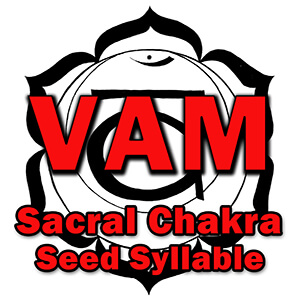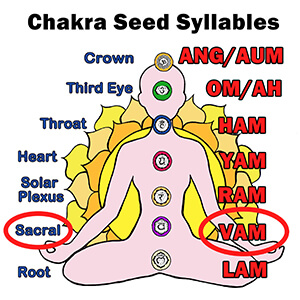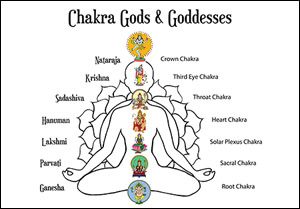Watch nearly 400 videos on the Vocal Medicine Channel!
Sacral Chakra Mantra
A sacral chakra mantra is one of the most direct ways to work with the vital energy in the second chakra. This is important for the emotional and psychological aspects of the sacral chakra as well as the health of the physical organs associated with the sacral chakra.
Sacral Chakra Seed Syllable
A simple sacral chakra mantra involves using the bija or beej seed syllable for this chakra. The bija seed syllables are fundamental sounds that connect to each of the seven chakras. The seed syllable for the sacral chakra mantra is VAM (pronounced “vuhm”).
Share this page with a friend!
Powerful Sacral Chakra Mantra
A simple and effective formula for chakra mantras is the sound OM followed by the chakra seed syllable, then the word “Namaha” and finally a repetition of the seed syllable. Thus, a simple mantra for the sacral chakra would be “OM VAM Namaha VAM.”
Meaning of OM in the Sacral Chakra Mantra
Typically, mantras begin with the sound OM. The Sanskrit word OM is familiar to most people. OM is the sound of the universe, the sound from which all other sounds are formed. OM serves to focus the mind at the beginning of a mantra.
Action of the Word OM
OM is said to draw the energy from the bottom of the spine to the top of the head. The energy of OM is one of expansion and ascension. In terms of healing, OM brings prana into the subconscious mind. OM is the sound of the sun and sheds light on addictive tendencies and negative emotions, bringing them to light for healing and transmutation.
Symbolic Meaning of OM
OM represents past, present and future. OM is a seed or building block of creation. OM is the mantra of assent, much like saying “amen” at the end of a prayer. In addition, when used at the beginning of a mantra, OM affirms the intention of the mantra.
Decoding the Seed Syllable VAM
After chanting the word OM, the sacral chakra mantra contains the seed syllable or bija for this chakra. The seed syllables originated in Tantric Hinduism or Esoteric Buddhism. Seed syllables are ancient, mystic sounds that capture the essence of a particular principle, often personified as a deity or buddha. The seed syllables do not have a specific translation, but are believed to contain great spiritual power.
The Energy of the “V” Consonant
The word VAM can be broken down into three letters or three sounds. The “V” sound is related to water energy. This energy is flowing, permeating and pervasive. The symbol of the seed syllable VAM is the white crescent moon. The related sense organ is the tongue or sense of taste. Additional organs of the body related to this chakra are the kidneys, reproductive organs and pancreas.
Central Vowel: Short “A”
The “a” in the word LAM is a short vowel pronounced “uh.” This vowel sound is directly connected to the root chakra. It is the most basic sound created when air passes over the vocal chords. This is a grounding sound that is present in the seed syllables for the first five chakras: LAM (root chakra), VAM (sacral chakra), RAM (solar plexus chakra), YAM (heart chakra) and HAM (throat chakra). This sound is especially important in a root chakra mantra.
Meaning of the Consonant “M”
The “M” at the end of the word LAM is the transformative energy of the universe and exists in the realm of thoughts and feelings. The sound “M” is a nearly universal sound associated with the feminine and the concept of motherhood ion languages around the world: mater, mama, mommy, matre, ma’am, moeder, ma, meme, majko, matka, mor, mere, maman, mutter, etc.
Putting It Altogether: VAM
When “VAM” is taken as a whole, the syllable is related to the water element. In the Ayurvedic system, the energy of LAM is kapha. This is the same energy that is found in the root chakra. Both of these chakras have the action of grounding the body in the physical plane. Kapha is one of the three fundamental patterns created by a unique combination of the five natural elements (fire, air, water, earth, ether). Kapha governs stability and structure.
Meaning of “Namaha”
Finally, the root chakra mantra closes with the word “Namaha.” This word is usually translated as “I bow,” “I give reverence” or “I honor.” In addition, the root “namah” is also present in the word “namaste,” which is used to end many yoga classes and indicates reverence for the Light that resides in each person. The word “Namaha” also encapsulates the syllable “ma,” bringing in the energy of the Divine Mother into the root chakra mantra.
Sacral Chakra Mantra Meaning
This mantra can be translated as, “I give honor to the energy of the sacral chakra.” This is a simple but powerful mantra that should be approached with caution. The chakra seed syllables are very powerful. This is the reason that some experts suggest starting with five minutes or less a day when practicing chants that use the chakra seed syllables.
Other Approaches
Other approaches to using a sacral chakra mantra would include singing or speaking affirmations for the sacral chakra, singing chants to the deities associated with the sacral chakra, or the practice of sacred toning with vowels sounds. We’ll look at these sacral chakra mantra options below.
More Resources
Learn more about the sacral chakra in the article Sacral Chakra Symbol Meaning. Or explore many facets of chakra mantras in Chakra Sounds & Seed Syllables.
Mantras to Sacral Chakra Deities
Another option for a sacral chakra mantra is to focus on the associated Hindu deities. Perhaps the most significant aspect of relating to a chakra god or goddess is the sense of a personal relationship. Giving devotion to a specific form of the deity can reinforce their positive characteristics within ourselves.
Sacral Chakra Gods and Goddesses
The sacral chakra is associated with a number of gods and goddesses including Vishnu, the goddess Rakini and the goddess Parvati. There are others, but these are three of the main sacral chakra deities. Vishnu is an incarnation of Krishna. In this incarnation, he is the consort of Lakshmi, the goddess of wealth.
Sacral Chakra Mantra to Parvati
Parvati is the Hindu goddess of fertility, love and devotion as well as divine strength and power. She is the gentle and nurturing aspect of the goddess energy and the consort of Shiva. Hear a sacral chakra mantra to Parvati and learn more about this goddess in the article Parvati Mantra.
Sacral Chakra Mantra to Vishnu
Vishnu is an incarnation of Krishna. In this incarnation, he is the consort of Lakshmi, the goddess of wealth. Vishnu is known as the preserver or the one who maintains the cosmos. He is one of the three persons of the Hindu trinity: Brahma (creator), Vishnu (preserver) and Shiva (destroyer). Mantras to Vishnu include Om Namo Bhagavate Vasudeva.
Sacral Chakra Mantra to the Goddess Rakini
Rakini is a Hindu goddess with two heads representing the duality between the external and internal worlds. This duality is also symbolized in light and dark, male and female, yin and yang, night and day, expansion and contraction and so forth. Rakini is one of the eight female yogis in tantric texts. A simple mantra to Rakini is Om Rakini Namaha.
Musical Note Names as Mantras
Solemnization is the practice of using syllables to teach pitch and sight reading. This practice aids in the recognition of the different steps of the scale. This approach originated in ancient India with a system known as sargam. Sargam is composed of seven tones called svaras or swaras.
System of Sargam
In the Indian system, the notes of the scale are paired with the following syllables: SA, RE, GA, MA, PA, DHA, NI, SA. Thus, the chakras and musical notes in this system would be: SA (root), RE (sacral), GA (solar plexus), MA (heart), PA (throat chakra), DHA (third eye chakra) and NI (crown chakra).
Attributes of the Sound RE
The sound “RE” for the sacral chakra is said to arise from the lowing of a bull. This sound is also associated with the planet Mars. The note RE is the second note of the scale and can be used to create a sacral chakra mantra. Singing this sound in different rhythms and at different speeds is a very simple sacral chakra mantra.
Meaning of the Sacral Chakra Sound
The full note name for the sacral chakra is “rishaba” or “rishabha.” The name means “a bull.” Sometimes “rishaba” refers to any male animal or to something that is excellent or medicinal. This is the second note in the classical Indian scale. In Jainism, rishaba refers to a spiritual leader. The bull symbolizes strength and stability.
For more information, read Chakras and Musical Notes.
Healing Mantras for the Sacral Chakra Organs
The sacral chakra is focused on relationships, including one’s relationship with oneself as well as others. The sacral chakra is known in Sanskrit as Svadhishthana, meaning literally “one’s own place.” This chakra is the realm of communication, exchange, and finances. In addition, the sacral chakra is the center of artistic creation as well as reproductive ability. Sometimes the sacral chakra is called the seat of the soul.
Sacral Chakra Mantras for the Body
The following are sacral chakra mantras for associated organs and systems:
REPRODUCTIVE ORGANS: Om Sam Sukratmane Namah Hrdayadi Daksa Padantam
BACK: Om Bam Namah Prsthe
Summary of Sacral Chakra Mantra Sounds
Bija Seed Syllable: VAM
Eastern Scale (Sargam): RE
Vowel Sound: OO
Musical Instrument: Wind
Sound Frequency: 480HZ
Hindu Deities: Vishnu, Parvati, Rakini
More Chakra Resources
SACRAL CHAKRA MANTRA ARTICLE SUMMARY
This article on finding a sacral chakra mantra includes a simple Vedic mantras using the Sanskrit seed syllable VAM. A video demonstrating the mantra “OM VAM Namaha VAM” is provided. Other topics include detailed explanations of the sounds of the sacral chakra as well as sacral chakra mantras to the Hindu deities associated with the second chakra.
Click for all content on our Site Map
Author Kathleen Karlsen
Kathleen Karlsen is a musician, artist, writer and speaker. She is the author of two books (Flower Symbols and Vocal Medicine) and over 200 articles. Kathleen, her husband Andrew, and their five children live in Bozeman, Montana. More about Kathleen Karlsen.
Share this page with a friend!
![]() Vocal Medicine Music on Spotify!
Vocal Medicine Music on Spotify!










